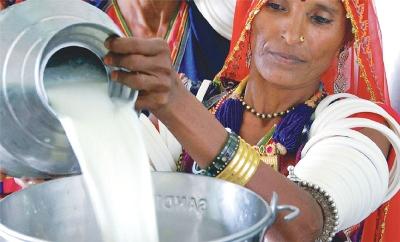NEW DELHI, 23 January 2017 : With Indian milk production registering a growth rate of 6.28 per cent during 2014-16, the country's per capita milk availability is above the global average.
Speaking during the inter-session meeting of the Parliamentary Consultative Committee of Ministry of Agriculture in New Delhi, Indian agriculture and farmers welfare minister, Radha Mohan Singh said that with this growth India has recorded a highest growth in the last ten years, which was about 4 per cent and three times more than the world average growth of 2.2 per cent.
India's per capita availability of milk in India is 337 gram/day as compared to the average world per capita availability of 229 gram/day, the minister said.
Milk production in India has increased from 22 million tonne in 1970 to 156 million tonne in 2015-16, which shows a growth of 700 percent during last 46 years.
Singh has said that milk production has become a major economic activity amongst rural households and farmers are adopting dairying along with agriculture for augmenting their incomes.
About 70 million rural households are engaged in milk production. The small and marginal farmers & landless labourer produce about one to three litres of milk per day and are responsible for production of most of the milk for the country, Singh opined.
About 78 percent farmers in India are small and marginal, who own about 75 percent of female bovine but own only 40 percent farm land. Milk contributes to one third of gross income of rural households and in case of landless its contribution is half in their gross income.
Agriculture Minister said that India continues to hold the number one position among milk producing nations of the world since 1998. India has largest bovine population in the world (18.4 percent share).
Singh said that during last two years 2014-16, milk production has registered a growth rate of 6.28 percent, which is more than last year growth rate of about 4 percent and more than three times higher than the world growth average of 2.2 percent. If wheat and paddy is combined together, even then, in Gross Value Addition (GVA) of Rs.4.92 crore in 2014-15, the contribution of milk is more than 37 percent.
About 54 percent of milk produced in the country is surplus, out of which about 38 percent is handled by the organized sector. The Co-operatives and private dairy organisations have equal share in it and women participation in dairying is about 70 per cent.
In order to encourage the farmers for increasing milk production, it is imperative that milk collection facilities need to be upgraded and farmers be given remunerative price for their produce. This is possible only when an effective management system is in place to link the farmers to the market. Shri Singh said that BPL households, small and marginal farmers will be encouraged to rear descript indigenous breeds.
Singh said that the National Bovine Breeding and Dairy Development Programme (NPBBDD) has been started in 2014-15 converging four existing programmes.
The objective of this programme is to prepare a comprehensive and scientific programme to meet the increasing demand for milk. The programme has two components – National Bovine Breeding programme (NPBB) and National Dairy Development Programme (NPDD).
The NPBB focusses on expanding field coverage for artificial insemination network, monitoring of programmes for indigenous breed development and conservation in the breeding areas.
The NPDD is focusing on creating and strengthening of infrastructure for milk unions/federations for production, procurement, processing & marketing of milk and training of dairy farmers and extension.
Image Credit: Indian Express




















